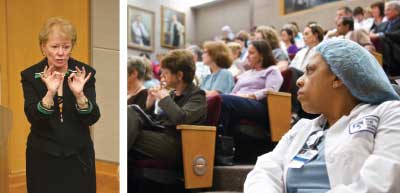Department of Nursing Welcomes Inaugural Karsh Visiting Professor

Joanne Disch speaks to a packed Bornstein Amphitheater.
Nurses and their inter-professional colleagues packed the Bornstein Amphitheater to hear inaugural Karsh visiting professor Joanne Disch, PhD, RN, FAAN, speak about the power of collaboration and the differences between a team of experts and an expert team.
“The intent of the Estrellita and Yousuf Karsh Visiting Professor program is to have a yearly opportunity to invite a nationally or internationally known nursing leader to visit BWH and have conversations with us about issues we deal with every day so that we can create an environment in which we can provide the best care,” said Mairead Hickey, PhD, RN, senior vice president of Patient Care Services and chief nursing officer. “We thank Mrs. Estrellita Karsh for her generosity in enabling us to create this program.”
Disch is a clinical professor and the Lillehei Chair in Nursing and Leadership and director of the Katherine J. Densford International Center for Nursing Leadership at the University of Minnesota School of Nursing. She presented “How to Create an Expert Team from a Team of Experts?”
Illustrating her point, she showed the audience a picture of the 2004 U.S. Olympic basketball “Dream Team.”
“Each player on this team was an icon in his own mind,” said Disch, a recognized leader in collaboration. “But as a team, they bombed. The team of experts only becomes an expert team when they work at it, have interconnectedness and know the goals of the team.” Disch described the qualities of the expert team, including:
Shared goals and shared mental models
Understanding and including everyone’s point of view
Leadership that varies according to the situation
Interconnectedness
Willingness and support to speak up for the good of the goal
Incentives for the team behavior and outcomes
Disch, a nurse for 42 years, talked about the way the health care team has evolved since she began her career as a bedside nurse. “When I started, respiratory therapy was not yet a specialty. Nurses and doctors worked closely together,” she said. “Now, there are so many roles—hospitalists, agency and travel nurses—and changes in residents’ work hours, which makes the collaboration even more essential.”
Communication is also vital to the success of a team. “It is the number one factor included on wrong site surgery, sentinel events and medication errors,” she said. “Research on collaboration and communication shows patients have better outcomes, the work environment is better and recruitment and retention are enhanced. The solution for complexity and change is for all of us to communicate, collaborate and share goals to get patients better.”
Throughout the day, Disch met with inter-professional collaborative teams in the MICU and Tower 14CD, in addition to a group of cardiovascular nurse practitioners. She noted that she was having “a rich day” of learning herself. “I have seen some phenomenal examples of this collaboration here—I think you have the structures and processes to ensure everyone’s voice is included in patient care,” she said, adding that she planned to take back what she had learned at BWH to the University of Minnesota School of Nursing.